Abstract
The frequency and magnitude of objectively determined myocardial ischaemia during normal daily activities of patients with varying severity of coronary artery disease are unknown. Furthermore, the incidence of nocturnal resting myocardial ischaemia and frequency of coronary spasm in patients with normal coronary arteries and chest pain are also not known. One hundred consecutive patients with chest pain referred for coronary angiography were therefore investigated with exercise testing and ambulatory ST segment monitoring. Fifty two of 74 patients with significant coronary artery disease and six of 26 with no significant coronary narrowing had episodes of ST segment change during 48 hours of ambulatory monitoring. Two patients, one with normal coronary arteries and localised spasm and one with three vessel disease, had episodes of ST segment elevation, whereas all other patients had episodes of ST segment depression. The frequency, duration, and magnitude of ST segment changes were greater in patients with more severe types of coronary artery disease. Thus more than six episodes of ST segment change per day occurred in patients with two or three vessel disease or left main stem stenosis and in the only patient with coronary spasm and normal coronary arteries. Nocturnal ischaemia occurred in 15% of patients with coronary artery disease and was almost an invariable indicator of two or three vessel coronary artery disease or left main stem stenosis. Episodes of ST segment change occurred most commonly during the morning hours and least commonly during the night, in parallel with changes in basal hourly heart rates. The heart rate at the onset of ST segment change tended to be lower in patients with coronary artery disease than in those with normal coronary arteries. The duration of exercise to ST segment depression tended to be shorter in patients with more severe disease, but it could not predict patients with nocturnal myocardial ischaemia, left main stem stenosis, or coronary spasm, whereas ambulatory ST segment monitoring was able to identify most of these patients.
Full text
PDF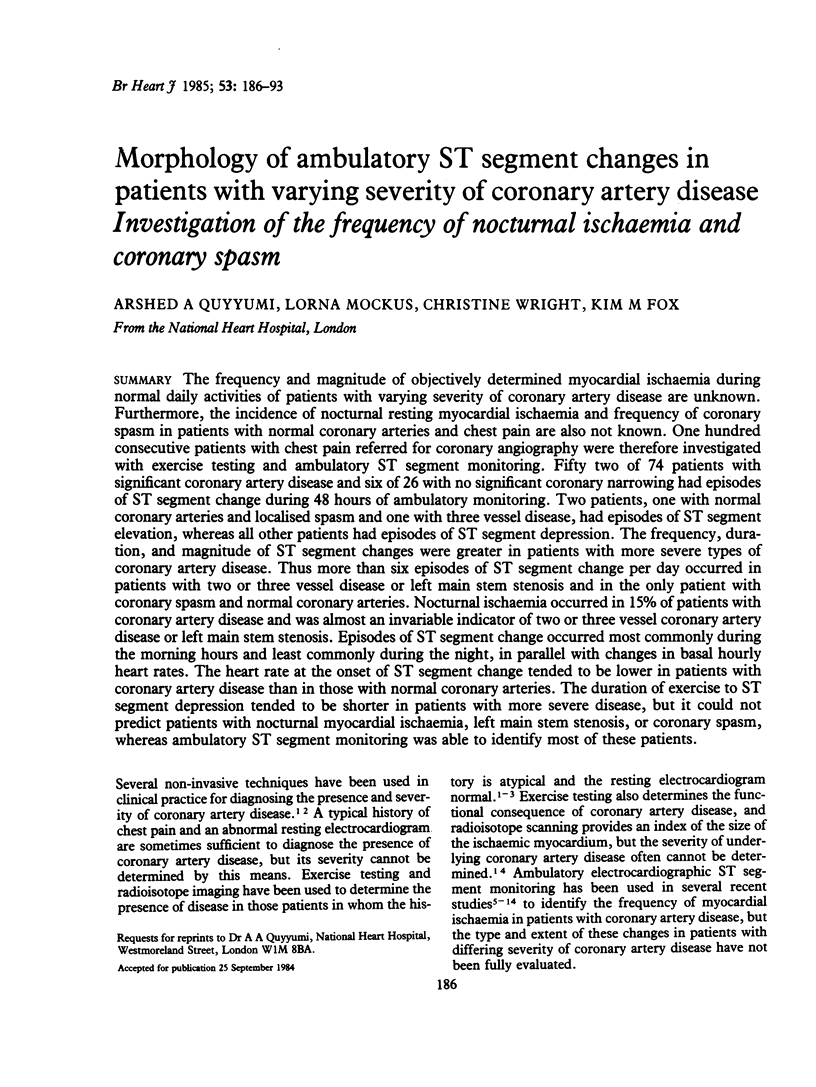
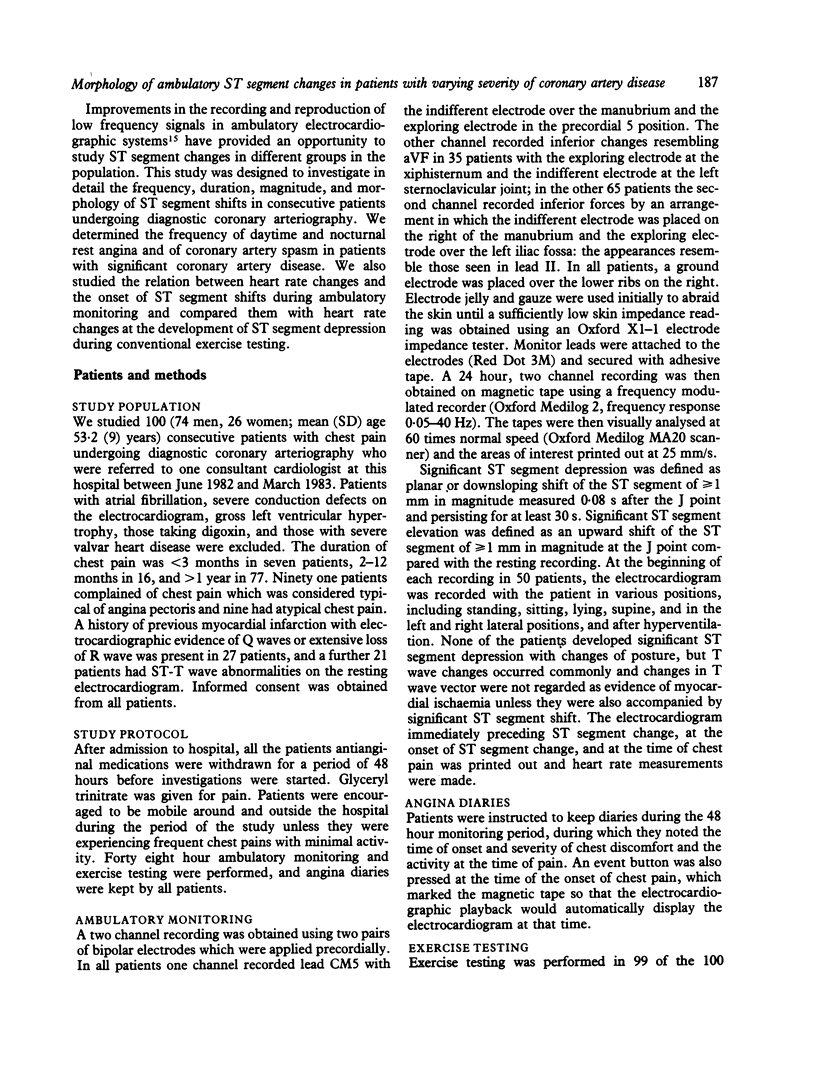
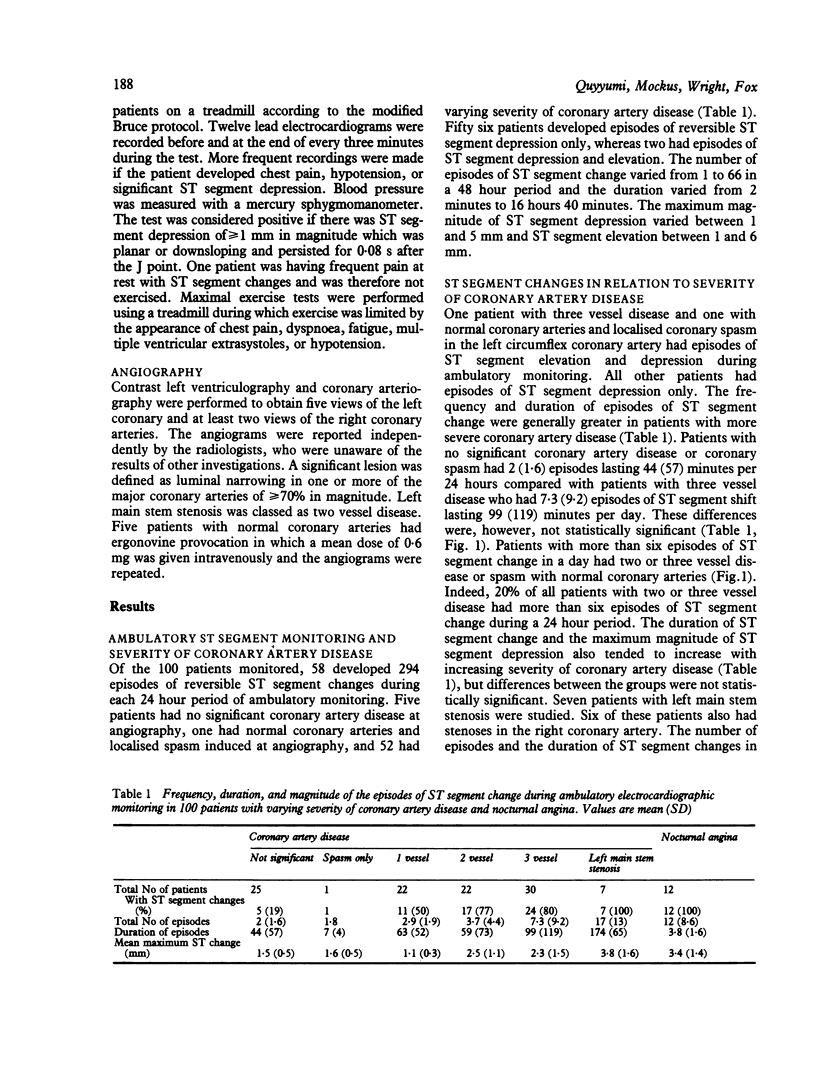
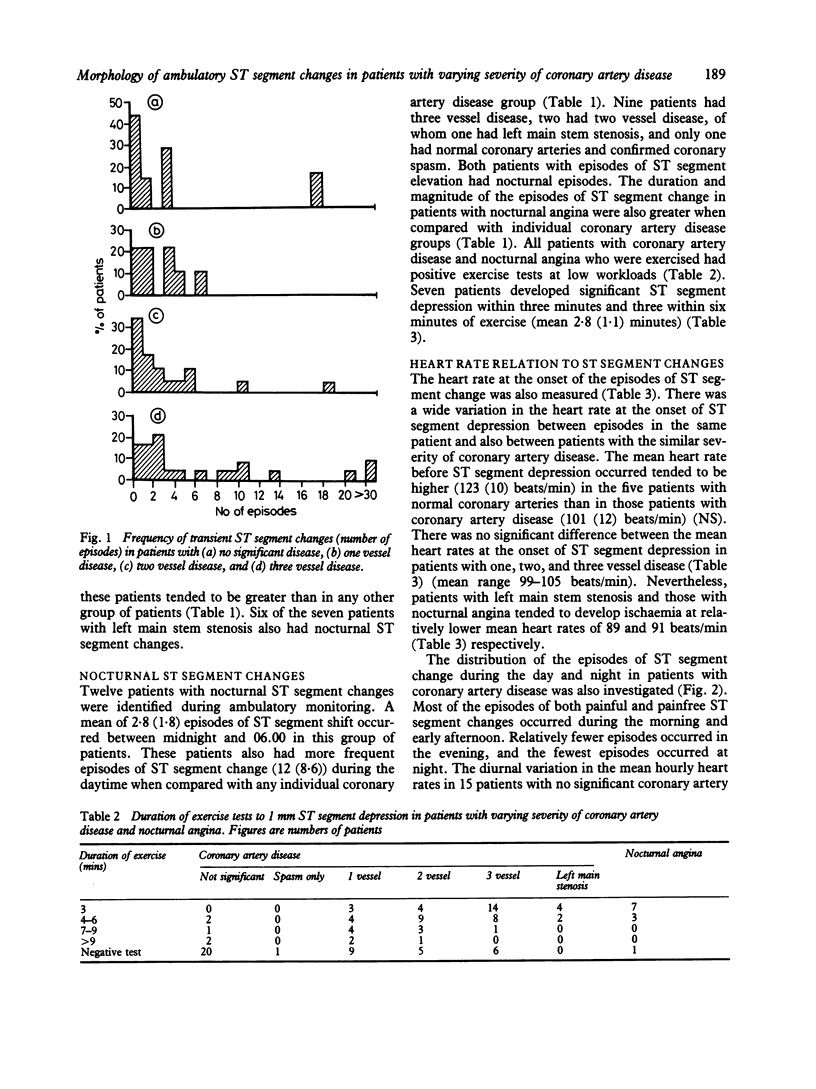
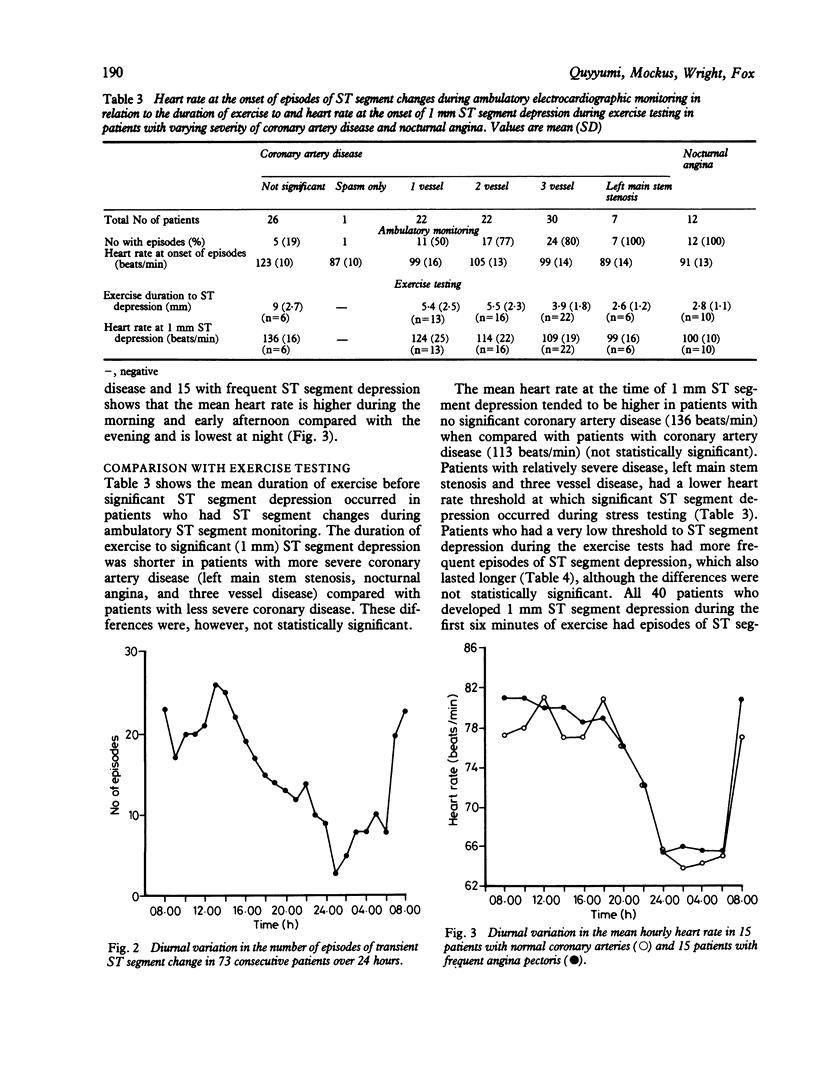
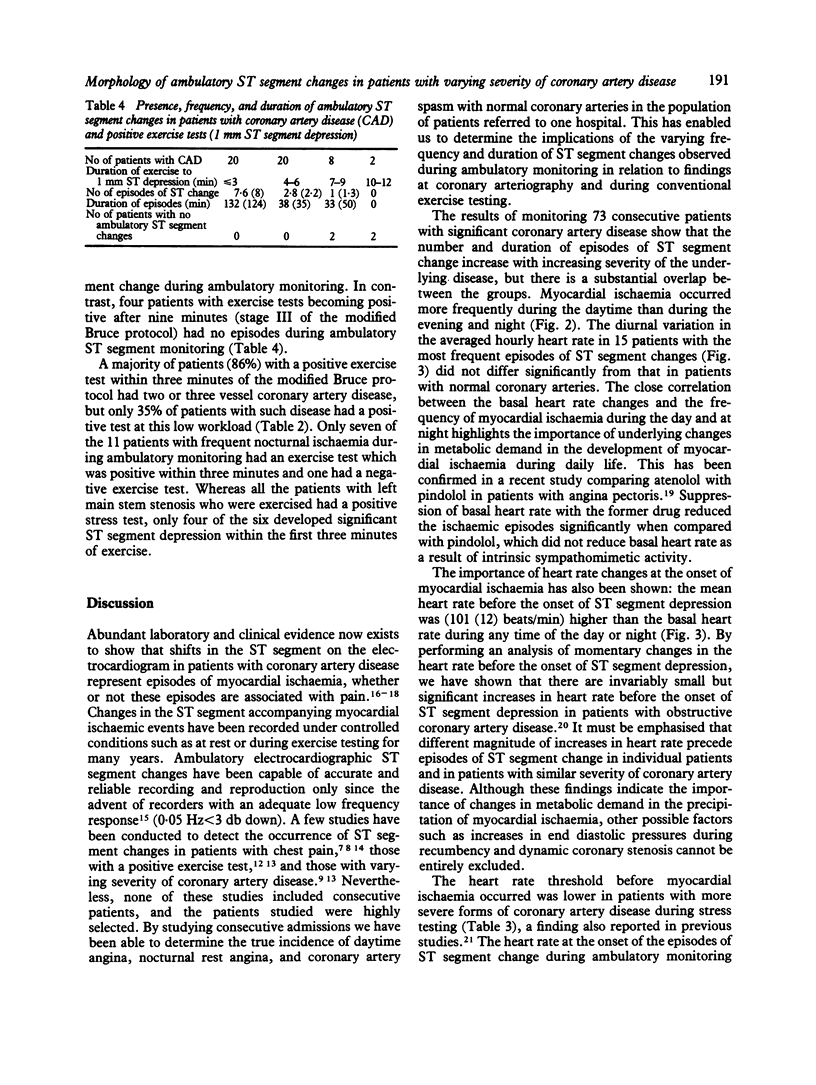
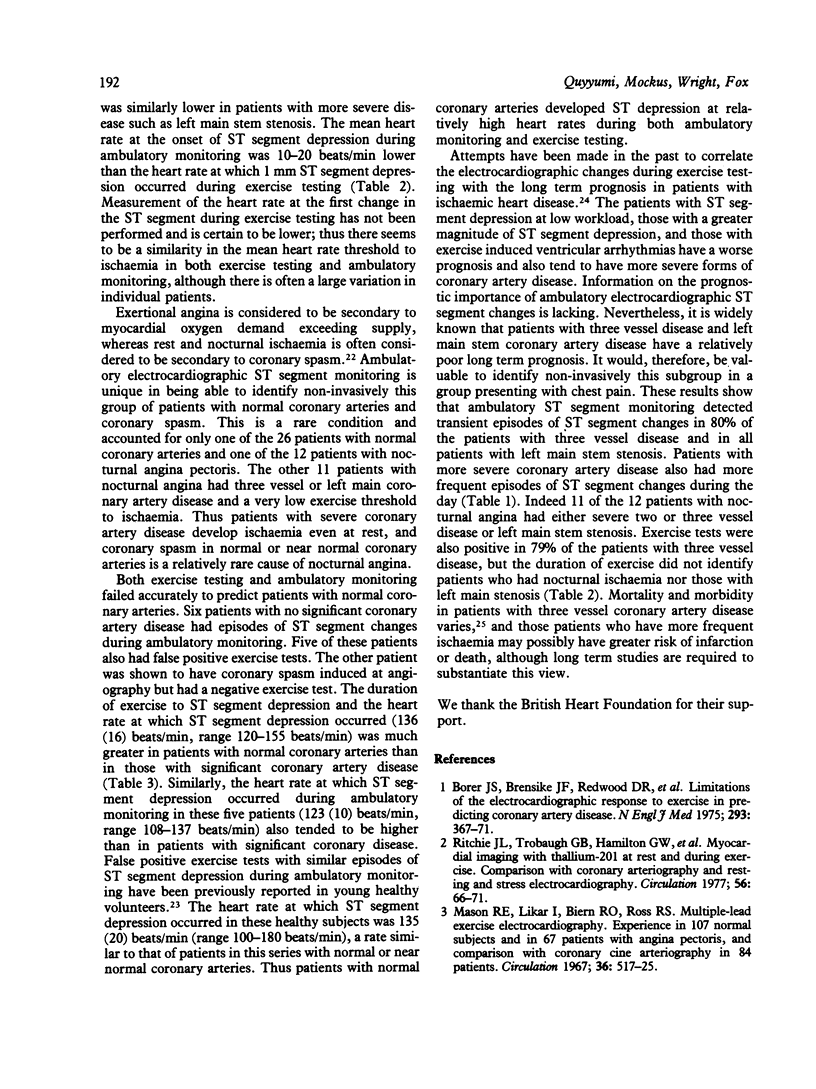
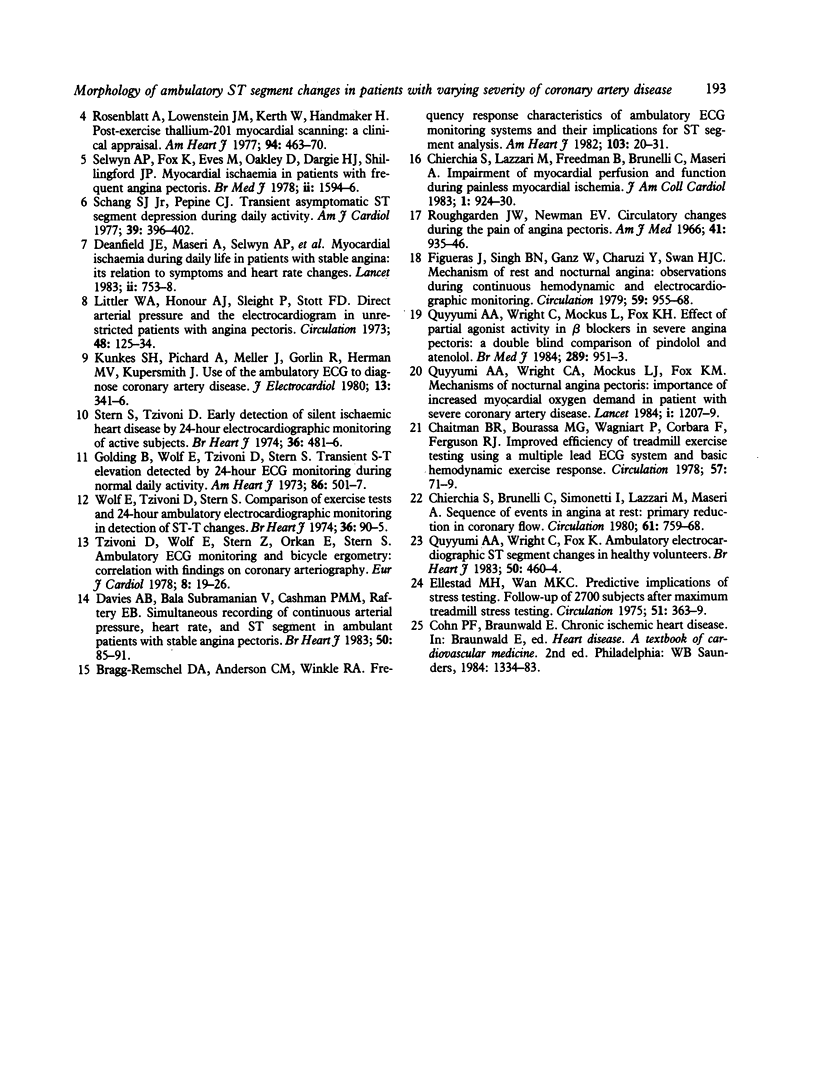
Selected References
These references are in PubMed. This may not be the complete list of references from this article.
- Borer J. S., Brensike J. F., Redwood D. R., Itscoitz S. B., Passamani E. R., Stone N. J., Richardson J. M., Levy R. I., Epstein S. E. Limitations of the electrocardiographic response to exercise in predicting coronary-artery disease. N Engl J Med. 1975 Aug 21;293(8):367–371. doi: 10.1056/NEJM197508212930801. [DOI] [PubMed] [Google Scholar]
- Bragg-Remschel D. A., Anderson C. M., Winkle R. A. Frequency response characteristics of ambulatory ECG monitoring systems and their implications for ST segment analysis. Am Heart J. 1982 Jan;103(1):20–31. doi: 10.1016/0002-8703(82)90524-5. [DOI] [PubMed] [Google Scholar]
- Chaitman B. R., Bourassa M. G., Wagniart P., Corbara F., Ferguson R. J. Improved efficiency of treadmill exercise testing using a multiple lead ECG system and basic hemodynamic exercise response. Circulation. 1978 Jan;57(1):71–79. doi: 10.1161/01.cir.57.1.71. [DOI] [PubMed] [Google Scholar]
- Chierchia S., Brunelli C., Simonetti I., Lazzari M., Maseri A. Sequence of events in angina at rest: primary reduction in coronary flow. Circulation. 1980 Apr;61(4):759–768. doi: 10.1161/01.cir.61.4.759. [DOI] [PubMed] [Google Scholar]
- Chierchia S., Lazzari M., Freedman B., Brunelli C., Maseri A. Impairment of myocardial perfusion and function during painless myocardial ischemia. J Am Coll Cardiol. 1983 Mar;1(3):924–930. doi: 10.1016/s0735-1097(83)80211-3. [DOI] [PubMed] [Google Scholar]
- Davies A. B., Bala Subramanian V., Cashman P. M., Raftery E. B. Simultaneous recording of continuous arterial pressure, heart rate, and ST segment in ambulant patients with stable angina pectoris. Br Heart J. 1983 Jul;50(1):85–91. doi: 10.1136/hrt.50.1.85. [DOI] [PMC free article] [PubMed] [Google Scholar]
- Deanfield J. E., Maseri A., Selwyn A. P., Ribeiro P., Chierchia S., Krikler S., Morgan M. Myocardial ischaemia during daily life in patients with stable angina: its relation to symptoms and heart rate changes. Lancet. 1983 Oct 1;2(8353):753–758. doi: 10.1016/s0140-6736(83)92295-x. [DOI] [PubMed] [Google Scholar]
- Ellestad M. H., Wan M. K. Predictive implications of stress testing. Follow-up of 2700 subjects after maximum treadmill stress testing. Circulation. 1975 Feb;51(2):363–369. doi: 10.1161/01.cir.51.2.363. [DOI] [PubMed] [Google Scholar]
- Figueras J., Singh B. N., Ganz W., Charuzi Y., Swan H. J. Mechanism of rest and nocturnal angina: observations during continuous hemodynamic and electrocardiographic monitoring. Circulation. 1979 May;59(5):955–968. doi: 10.1161/01.cir.59.5.955. [DOI] [PubMed] [Google Scholar]
- Golding B., Wolf E., Tzivoni D., Stern S. Transient S-T elevation detected by 24-hour ECG monitoring during normal daily activity. Am Heart J. 1973 Oct;86(4):501–507. doi: 10.1016/0002-8703(73)90142-7. [DOI] [PubMed] [Google Scholar]
- Kunkes S. H., Pichard A., Meller J., Gorlin R., Herman M. V., Kupersmith J. Use of the ambulatory ECG to diagnose coronary artery disease. J Electrocardiol. 1980 Oct;13(4):341–346. doi: 10.1016/s0022-0736(80)80085-9. [DOI] [PubMed] [Google Scholar]
- Littler W. A., Honour A. J., Sleight P., Stott F. D. Direct arterial pressure and the electrocardiogram in unrestricted patients with angina pectoris. Circulation. 1973 Jul;48(1):125–134. doi: 10.1161/01.cir.48.1.125. [DOI] [PubMed] [Google Scholar]
- Quyyumi A. A., Wright C. A., Mockus L. J., Fox K. M. Mechanisms of nocturnal angina pectoris: importance of increased myocardial oxygen demand in patients with severe coronary artery disease. Lancet. 1984 Jun 2;1(8388):1207–1209. doi: 10.1016/s0140-6736(84)91693-3. [DOI] [PubMed] [Google Scholar]
- Quyyumi A. A., Wright C., Fox K. Ambulatory electrocardiographic ST segment changes in healthy volunteers. Br Heart J. 1983 Nov;50(5):460–464. doi: 10.1136/hrt.50.5.460. [DOI] [PMC free article] [PubMed] [Google Scholar]
- Quyyumi A. A., Wright C., Mockus L., Fox K. M. Effect of partial agonist activity in beta blockers in severe angina pectoris: a double blind comparison of pindolol and atenolol. Br Med J (Clin Res Ed) 1984 Oct 13;289(6450):951–953. doi: 10.1136/bmj.289.6450.951. [DOI] [PMC free article] [PubMed] [Google Scholar]
- Ritchie J. L., Trobaugh G. B., Hamilton G. W., Gould K. L., Narahara K. A., Murray J. A., Williams D. L. Myocardial imaging with thallium-201 at rest and during exercise. Comparison with coronary arteriography and resting and stress electrocardiography. Circulation. 1977 Jul;56(1):66–71. doi: 10.1161/01.cir.56.1.66. [DOI] [PubMed] [Google Scholar]
- Rosenblatt A., Lowenstein J. M., Kerth W., Handmaker H. Post-exercise thallium-201 myocardial scanning: a clinical appraisal. Am Heart J. 1977 Oct;94(4):463–470. doi: 10.1016/s0002-8703(77)80041-0. [DOI] [PubMed] [Google Scholar]
- Roughgarden J. W., Newman E. V. Circulatory changes during the pain of angina pectoris. 1772-1965--a critical review. Am J Med. 1966 Dec;41(6):935–946. doi: 10.1016/0002-9343(66)90051-9. [DOI] [PubMed] [Google Scholar]
- Schang S. J., Jr, Pepine C. J. Transient asymptomatic S-T segment depression during daily activity. Am J Cardiol. 1977 Mar;39(3):396–402. doi: 10.1016/s0002-9149(77)80095-7. [DOI] [PubMed] [Google Scholar]
- Selwyn A. P., Fox K., Eves M., Oakley D., Dargie H., Shillingford J. Myocardial ischaemia in patients with frequent angina pectoris. Br Med J. 1978 Dec 9;2(6152):1594–1596. doi: 10.1136/bmj.2.6152.1594. [DOI] [PMC free article] [PubMed] [Google Scholar]
- Stern S., Tzivoni D. Early detection of silent ischaemic heart disease by 24-hour electrocardiographic monitoring of active subjects. Br Heart J. 1974 May;36(5):481–486. doi: 10.1136/hrt.36.5.481. [DOI] [PMC free article] [PubMed] [Google Scholar]
- Tzivoni D., Wolf E., Stern Z., Orkan E., Stern S. Ambulatory ECG monitoring and bicycle ergometry: correlation with findings on coronary arteriography. Eur J Cardiol. 1978 Aug;8(1):19–26. [PubMed] [Google Scholar]
- Wolf E., Tzivoni D., Stern S. Comparison of exercise tests and 24-hour ambulatory electrocardiographic monitoring in detection of ST-T changes. Br Heart J. 1974 Jan;36(1):90–95. doi: 10.1136/hrt.36.1.90. [DOI] [PMC free article] [PubMed] [Google Scholar]


